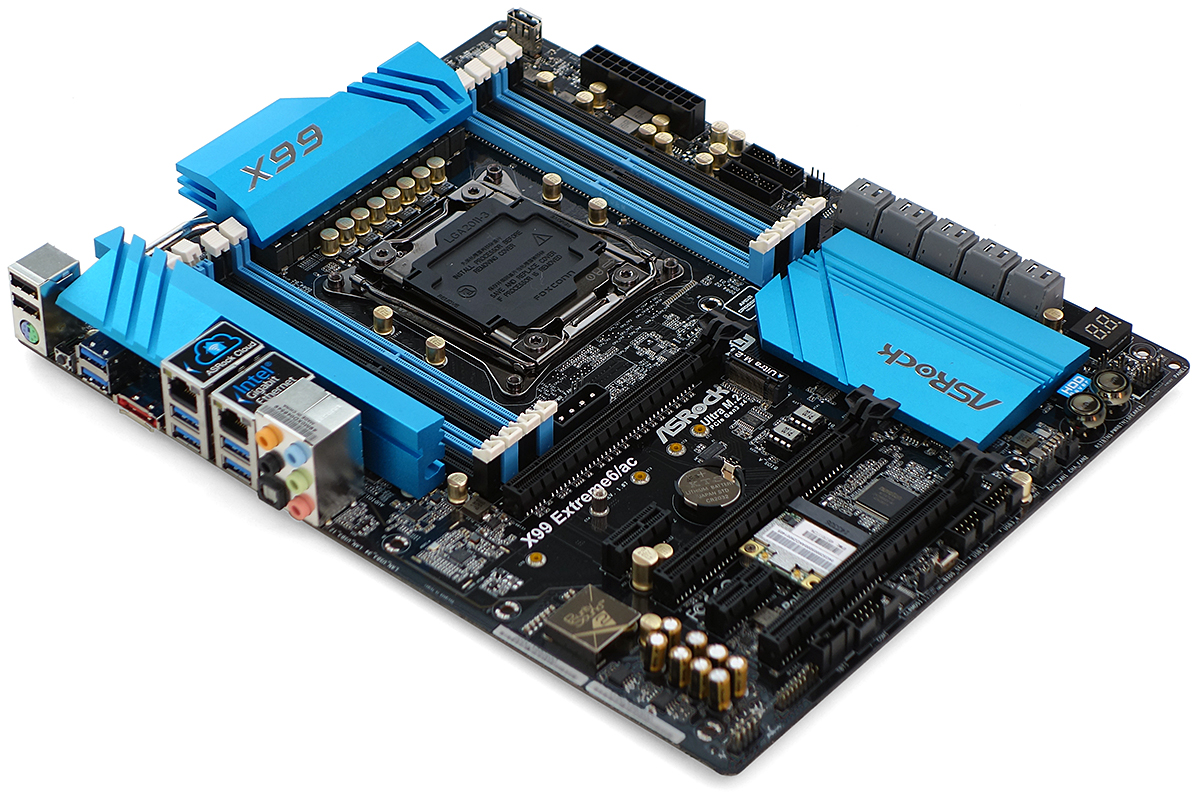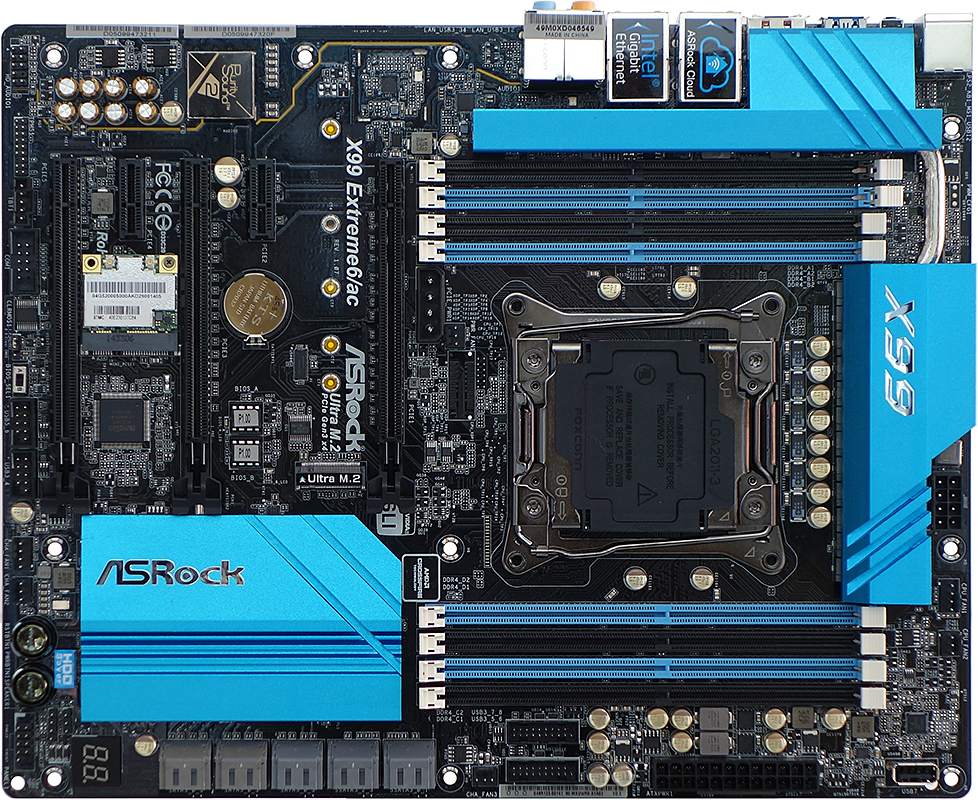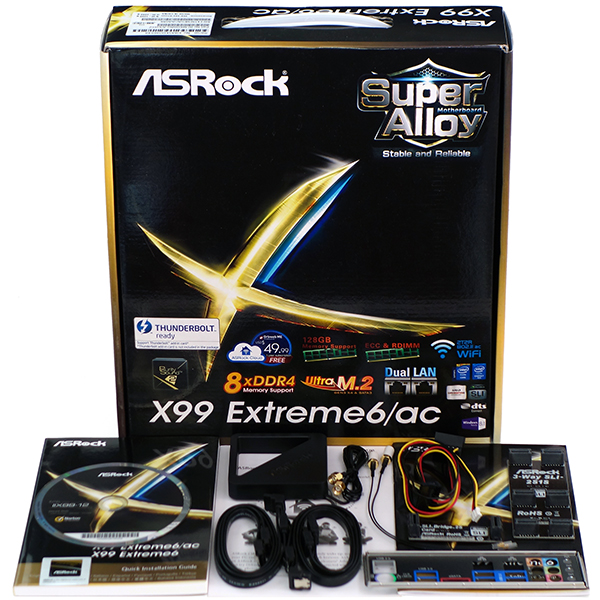ASRock X99 Extreme6/ac Motherboard Review
Featuring the same wireless controller as its closest competitor, ASRock’s X99 Pro adds a second gigabit Ethernet controller and removes a few pathway sharing issues. Have we finally found a value-winning solution for high-end LGA 2011-v3 buyers?
Why you can trust Tom's Hardware
ASRock’s X99 Extreme6/ac In Detail
A PCIe 3.0 configuration that drops from x16-x16-x8 to x16-x8-x4 when using a 28-lane CPU might not be a big deal to most builders, since so few use three-way SLI anyway. And a configuration that drops the third slot entirely might not be a deal-killer to PCIe-based M.2 SSD users, since so few of them need a third x16-length slot. It’s not as though an enthusiast would automatically lose that slot with any M.2 SSD. After all, ASRock does provide it a single SATA 6Gb/s connection as an alternative. Instead, we’re probably only looking at power users attempting to build the ultimate mid-price gaming machine as this board's missed target.
A comparison of ASRock's X99 Extreme6/ac to Asus' X99 Pro is inevitable, since both boards use the same PCIe 3.0 slot configuration and add-in USB 3.0 controllers. ASRock connects all four ports of its USB 3.0 hub to a single 5Gb/s chipset port, along with the two ports of the additional PCIe-based controller to a single 5Gb/s lane. ASRock goes on to add a second gigabit Ethernet controller and a single eSATA port compared to its competitor, relocating the Wi-Fi antenna connectors to the I/O shield in the process.
Dissimilarities between the Qualcomm Atheros network controller and Intel-based network PHY prevent teaming.
ASRock doesn’t feature its competitor’s custom firmware flashing ASIC, but does add a feature that many enthusiast appreciate in its dual, manually-selectable firmware ROMs. Both can even be removed and replaced, just in case you suffer an extremely unfortunate combination of bad luck and poor judgment.
Lacking its competitor’s four-lane PCIe 2.0 x16 connector, ASRock's customers can’t suffer the loss of the wireless controller by setting that slot to x4 mode. The same goes for the I/O panel-based USB 3.0. ASRock instead puts a PCIe x1 slot in the same place, refusing to overcommit the chipset’s eight-lane PCIe 2.0 controller. Sometimes, the simplest solutions are best.
As with Asus' board, four of the X99 Extreme6/ac’s six X99-based USB 3.0 ports are connected to front-panel headers. Unlike the competition, ASRock places both headers above the X99 Extreme6/ac’s top expansion slot to prevent any possible installation conflicts.
The X99 Extreme6/ac doesn’t offer Asus' SATA-Express connector, instead relying exclusively on Ultra M.2 (in PCIe x4 mode) or, for those who aren’t willing to disable the third PCIe 3.0 slot, traditional SATA RAID. Similarly, its competitor’s array of dual-control (voltage and PWM) four-pin fan connectors is reduced on the X99 Extreme6/ac to two four-pin and four three-pin headers.
Get Tom's Hardware's best news and in-depth reviews, straight to your inbox.
Unique to ASRock is the HDD Saver connector, which can enable or disable power to two hard drives on demand. Password-securable, users can turn off the drive to save power and wear, and to prevent access by “friendly” guests, even while keeping their Windows user logged in. I’ve read that the technology can be used to prevent seldom-used mechanical drives from locking up (by occasionally power-cycling them), though I’ve never personally had an unused drive seize in storage.
One ever-present layout concern is the front-panel audio header shoved all the way into the X99 Extreme6/ac’s bottom-rear corner. Typically opposite of the port’s placement on a case, we still find that the cables of some cases are slightly too short to reach that corner. ASRock’s competitor beats the X99 Extreme6/ac on this, since the X99 Pro’s connector was moved forward by more than an inch.
The X99 Extreme6/ac installation kit includes two- and three-way SLI bridges, four SATA cables, a two-drive SATA power cable for the HDD Saver header, antenna leads for the I/O panel and a Wi-Fi antenna.
Current page: ASRock’s X99 Extreme6/ac In Detail
Prev Page The Lane Games Next Page X99 Extreme6/ac Firmware And Software-
vertexx Still looking for the value X99 board without too many trade-offs. What would be helpful for me is a chart comparing the x99 board with the various slot/lane options for the 5820 vs. 5930/5960 CPUs.Reply -
JeanLuc You haven't shown any results for the SATA and ESATA throughput, the USB controllers transfer speeds (Intel speeds I would guess are the same across the board but what the 3rd party controllers?).Reply
Anyone who is buying this will also want to know how good the wireless AC and bluetooth that have been bundled with the motherboard are.
How good is the sound chip? Can you hear background static when you have earphones plugged in if so how bad? Has the manufacturer made any effort to isolate background noise and how effective are those measures?
There is so much you have missed in this "review". -
Crashman Reply
Right now Gigabyte has the best lane configuration and slot spacing four four cards, MSI has the best lane configuration and slot spacing for three. Gigabyte has the USB 3.0 header blocked by a fourth card, MSI has the three cards + PCIe x4 M.2 +USB 3.0 configuration nailed (if you care about PCIe x4 M.2). You'll see another MSI board in a review still pending its publishing date.15149683 said:Still looking for the value X99 board without too many trade-offs. What would be helpful for me is a chart comparing the x99 board with the various slot/lane options for the 5820 vs. 5930/5960 CPUs.
-
Crashman Reply
That's it, I'm asking Adam Overa to find a controller tester :) We should have a collection of standard controller test results to link when discussing the inclusion of these parts on a motherboard.15149944 said:You haven't shown any results for the SATA and ESATA throughput, the USB controllers transfer speeds (Intel speeds I would guess are the same across the board but what the 3rd party controllers?).
Anyone who is buying this will also want to know how good the wireless AC and bluetooth that have been bundled with the motherboard are.
How good is the sound chip? Can you hear background static when you have earphones plugged in if so how bad? Has the manufacturer made any effort to isolate background noise and how effective are those measures?
There is so much you have missed in this "review".
-
vertexx Reply15153170 said:Right now Gigabyte has the best lane configuration and slot spacing four four cards, MSI has the best lane configuration and slot spacing for three. Gigabyte has the USB 3.0 header blocked by a fourth card, MSI has the three cards + PCIe x4 M.2 +USB 3.0 configuration nailed (if you care about PCIe x4 M.2). You'll see another MSI board in a review still pending its publishing date.
That about summarizes it - thanks! I'm looking at a 5820k based rig. Long term goal is water-cooled 3-way x8 + PCIe x4 M.2. So, MSI has that configuration down. Shorter term would more realistically be air-cooled 2-way, and my understanding is the MSI is not the best for 2-way air cooled due to the slot spacing.
So I think I'm looking for a board that can do both a (1) dual SLI x16/x0/x8 + x4 M.2 or (2) 3-way SLI x8/x8/x8 +x4 M.2, all at just above $200.
The lowest price board I could find that can do this is the ASRock x99 Fatal1ty Pro or OC Formula, both in the $340-350 price range. The Professional happens to have a $40 rebate plus $85 DDR4 combo discount, making this a ~$220 proposition for this board. Tempting......
http://www.newegg.com/Product/Product.aspx?Item=N82E16813157539 -
Crashman Reply
Please consider our first roundup:15154249 said:15153170 said:Right now Gigabyte has the best lane configuration and slot spacing four four cards, MSI has the best lane configuration and slot spacing for three. Gigabyte has the USB 3.0 header blocked by a fourth card, MSI has the three cards + PCIe x4 M.2 +USB 3.0 configuration nailed (if you care about PCIe x4 M.2). You'll see another MSI board in a review still pending its publishing date.
That about summarizes it - thanks! I'm looking at a 5820k based rig. Long term goal is water-cooled 3-way x8 + PCIe x4 M.2. So, MSI has that configuration down. Shorter term would more realistically be air-cooled 2-way, and my understanding is the MSI is not the best for 2-way air cooled due to the slot spacing.
So I think I'm looking for a board that can do both a (1) dual SLI x16/x0/x8 + x4 M.2 or (2) 3-way SLI x8/x8/x8 +x4 M.2, all at just above $200.
The lowest price board I could find that can do this is the ASRock x99 Fatal1ty Pro or OC Formula, both in the $340-350 price range. The Professional happens to have a $40 rebate plus $85 DDR4 combo discount, making this a ~$220 proposition for this board. Tempting......
http://www.newegg.com/Product/Product.aspx?Item=N82E16813157539
http://www.tomshardware.com/reviews/intel-x99-haswell-e-overclocking,3934.htmlIt has 2nd-tier (price-range) X99 motherboards with Gigabyte, ASRock and MSI compared, and it has the PCIe stuff you're looking for. In regards to the 5820K, MSI has "4 (x16/x8/x0/x4*, x8/x8/x8/x4*) *Forces M.2 to PCIe 2.0 x2" What this means is that the fourth slot is shared between M.2 and "PCIe x16 slot 4" I believe MSI's entire X99 range is made the same way, apart from the boards that have a PCIe 48-lane switch.
So MSI gets you 3-way + an x4 M.2. Most people are only interested in 2 way SLI as a future upgrade, and ASRock does 2-way + an x4 M.2.
It could be a while before we get down to the lowest X99 pricing tier, but expect coverage of MSI's cheap X99 board in "some other kind of article" three weeks from now.



